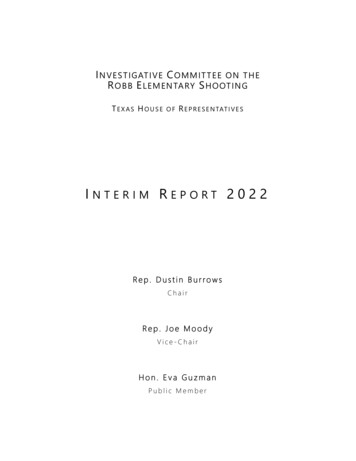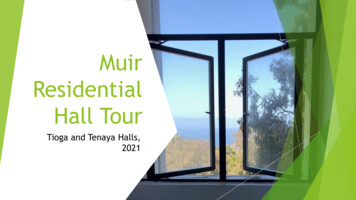
Transcription
COMMONWEALTH OF PENNSYLVANIAHOUSE OF REPRESENTATIVESENVIRONMENTAL RESOURCES AND ENERGY COMMITTEEPUBLIC HEARINGSTATE CAPITOLHARRISBURG, PAIRVIS OFFICE BUILDINGROOM G-50MONDAY, OCTOBER 28, 2 0198:00 A.M.PRESENTATION ONCARBON EMISSIONS AND ABLEHONORABLEHONORABLEHONORABLEDARYL METCALFE, MAJORITY CHAIRMANCRIS DUSHJONATHAN FRITZR. LEE JAMESKATHY RAPPPAUL SCHEMELGREG VITALI, DEMOCRATIC CHAIRMANCAROLYN COMITTAMARY JO DALEYMARY ISAACSONDANIELLE FRIEL OTTENPERRY WARRENMIKE ZABELPennsylvania House of RepresentativesCommonwealth of Pennsylvania
2ALSO PRESENT:REPRESENTATIVE ERIC NELSONREPRESENTATIVE STEVE MCCARTERSTAFF PRESENT:GLENDON KINGMAJORITY EXECUTIVE DIRECTORGRIFFIN CARUSOMAJORITY RESEARCH ANALYSTALEX SLOADMAJORITY RESEARCH ANALYSTPAM NEUGARDMAJORITY ADMINISTRATIVE ASSISTANTRICHARD FOXDEMOCRATIC EXECUTIVE DIRECTOR
3I N D E XTESTIFIERS kkkNAMEPAGEPATRICK MCDONNELLSECRETARY,DEPARTMENT OF ENVIRONMENT PROTECTION. . 7KEVIN DAYARATNA, Ph.D.SENIOR STATISTICIAN AND RESEARCH PROGRAMMER,THE HERITAGE FOUNDATION. . 23DAVID LEGATES, Ph.D.PROFESSOR OF CLIMATOLOGY,UNIVERSITY OF DELAWARE. . 31ROB ALTENBURG, ESQ.DIRECTOR OF ENERGY CENTER,PENNFUTURE. . 49TOM SCHUSTERSENIOR CAMPAIGN REPRESENTATIVE,BEYOND COAL CAMPAIGN,SIERRA CLUB. . 54DAVID MASUREXECUTIVE DIRECTOR,PENNENVIRONMENT. . 62GREGORY WRIGHTSTONEGEOLOGIST, AUTHOR, AND EXPERT REVIEWER,INTERGOVERNMENTAL PANEL ON CLIMATE CHANGE,SIXTH ASSESSMENT REPORT (AR6). . 81GORDON TOMBSENIOR FELLOW,COMMONWEALTH FOUNDATION. . 90JOHN WALLISER, ESQ.SENIOR VICE PRESIDENT,LEGAL AND GOVERNMENT AFFAIRS,PA ENVIRONMENTAL COUNCIL ANDDEP CITIZENS ADVISORY COUNCIL.102
4I N D E XTESTIFIERS(cont’d) kkkNAMEPAGEIRINA MARINOV, Ph.D.CLIMATE SCIENTIST,UNIVERSITY OF PENNSYLVANIA. 109MARC MORANOCOMMUNICATIONS DIRECTOR,COMMITTEE FOR A CONSTRUCTIVE TOMORROW; ANDFOUNDER,CLIMATE DEPOT. 128SUBMITTED WRITTEN TESTIMONY k k k(See submitted written testimony and handouts online.)
51P R O C E E D I N G S2* * *34MAJORITY CHAIRMAN METCALFE:The EnvironmentalResources and Energy Committee is called to order.Before we get started with the attendance, if56everyone could please rise and if I could ask7Representative Rapp, would you lead us in the Pledge,8m a ’am?910(The Pledge of Allegiance was recited.)1112131415MAJORITY CHAIRMAN METCALFE:Thank you.Thankyou, Representative Rapp.If I could ask our Member Secretary,Representative Dush, to call the attendance, please?1617(Roll was taken.)18192021MAJORITY CHAIRMAN METCALFE:Thank you,Representative Dush.This morning’s public hearing that w e ’re having22is on Pennsylvania’s CO2 and the climate, and we have a23number of guests with us today.24House security, and if anybody’s going to be staying in25attendance, unless you’re the press, if you could pleaseI was talking with our
61take one of the seats that are available.2some seats left, but they are going to ask that everybody's3seated today.4We still haveAnd I would also like to remind the Members of5the Committee that all the folks that we'll be talking with6here today and questioning and hearing testimony from are7all our guests and that we want to make sure that their8time is respected and their presentation is respected.9This isn't time for us to debate with our guests, so10they're here to provide information.11each other on this issue, I know, later at other meetings,12but today is not an opportunity for us to debate with our13guests; it's an opportunity for us to receive testimony14from our guests.15that amongst ourselves at a future meeting.16We'll debate amongstAnd then we'll digest that and debateSo while we're doing the Q&A, we ask Members to17hold their questions to one question per Member, and if we18have time to go back for a second question with any one of19the Members that might have had a second question, then20we'll do a second round of questions if we still have time21with that guest.22the timings that are outlined in today's schedule so that23we respect both the time of our guests and the time of the24Members that are here participating today.25But we're going to attempt to stay withWe did start a little earlier than normal for a
71Monday morning for receiving testimony, so the Members will2be coming and going today for other meetings also.3And we are joined by Representative Nelson also,4who is with the Republican Caucus and one of the Chairs of5the Oil and Gas Caucus, so has an interest in the issue.6appreciate him being with us this morning also - 7REPRESENTATIVE NELSON:8MAJORITY CHAIRMAN METCALFE:9IThank you.-- especially earlyin the morning on a Monday.10Our first testifier is the Secretary of the DEP,11Secretary Patrick McDonnell, and I would ask the Secretary12to join us at the microphone and share with us what he came13to share today, and then we look forward to a bit of a Q&A14with him also.15Thank you, sir.SECRETARY MCDONNELL:Thank you very much.Thank16you, Chairman Metcalfe, Chairman Vitali, Members, a17pleasure to be here with you bright and early on a Monday18morning to talk about climate change.19First, and I think most of you remember a month20ago I was here testifying on a lot of the same subjects,21so, one, I would encourage you to go back and reference22that testimony.23providing here this morning as well.24summarize and then open for questions.25There’s additional testimony w e ’reI ’ll brieflyThe first thing, and I think it’s the obvious
81thing to state, but climate change is real, and w e ’re2seeing the impacts of that here within the Commonwealth of3Pennsylvania.4are things we are now seeing come to pass.5percent increase in precipitation in the State with6modeling suggesting an additional 8 percent increase in7that precipitation by 2050, 14 percent increase in our8winter precipitation in that same time period.9since 1900 a 1.8 degree Fahrenheit increase in ourPredictions from 10, 20, even 40 years agoWe've seen 10We've seen10temperatures in the State.115.4 degree Fahrenheit increase in that temperature by 2050.Again, the modeling suggests aWe're seeing impacts globally.12We're seeing13impacts within our State.14on sea levels, on floods, on heat, on disease within the15State.We're seeing impacts on oceans,16To put some of this in historical context, which17was not something I'd addressed in the previous testimony,18you know, there's been a lot of science over time around19climate.201965 when Lyndon B. Johnson had a study done that showed a21changing climate and that humans were likely the cause.22addition to that, in 1979 and again in 1982, ExxonMobil23commissioned studies that showed the climate was predicted24to change and that that change was based substantially on25human-induced carbon emissions, as did Shell in 1988.The first real piece of it within the U.S. was inIn
91One thing about the science because I think, you2know, oftentimes we talk about the 97 percent of scientists3agree, and that I ’ll just say it sounds like or can be4construed as people hear it as opinion and just, again,5reminding that the nature of science itself is scientists6can test information, scientists testing and replicating7studies that other scientists do.8builds upon one another, that they’re constantly testing9each other’s theories and hypotheses in order to reachIt is something that10their conclusions.11even going back to some of those memos and studies in the12late ’70s and ’80s, it is exactly what w e ’ve seen come to13pass here over the last 30 years.And in fact, as I said, a lot of whatIn Pennsylvania our greenhouse gas emissions have1415decreased 12 percent between 2005 and 2015.16start for us as a Commonwealth, but it’s both not fast17enough, and modeling that w e ’ve done as part of our climate18assessment shows that that is projected to start going back19up within the next few years.20That is a goodYou know, one of the critiques I ’ve heard is why21should Pennsylvania engage in this in terms of what our22impact is.23if we were going at this alone.24hundred and eighty-seven countries have signed on to the25Paris Agreement.I ’d say it’s a valid thing maybe to point outHowever, we are not.The U.S. has committed to pull out ofOne
101that in 2020.2States, 25 of the States have joined the U.S. Climate3Alliance and have made commitments substantially similar to4what can be found within the Paris Agreement.5not alone by any means, and it will in fact take the6collective effort of nations and States in order to address7the climate crisis.But even within the U.S., now half of theSo we are8The most recent action taken by the9Administration was an executive order signed a few weeks10ago now by Governor Wolf.11Department of Environmental Protection to propose a12regulation by July of next year that would have the impact13of including the Commonwealth of Pennsylvania in the14Regional Greenhouse Gas Initiative.15That executive order directs theFor those who may not be aware, the Regional16Greenhouse Gas Initiative is a regional cap-and-trade17system that includes States in the Northeastern and mid-18Atlantic sections of the U.S.19establishing its own individual State budget for carbon,20adopting a model rule that then allows the linkage of those21State programs so that credits, allowances can be traded22across State boundaries, which has the impact of both23reducing carbon but also reducing the relative cost of24implementing those carbon reductions.25That includes each StateIn terms of where we are as a State with clean
111energy and jobs, I'll point out one out of every three of2our jobs now comes from the clean energy sector.3within the energy sector, one out of every three jobs in4Pennsylvania is in the clean energy sector.5about where we were even 10, 15 years ago, that has come a6substantial way.7Again,If you thinkThe RGGI States have -- you know, I mentioned the812 percent overall reduction we've had.9had a 45 percent reduction within their power sector sinceRGGI States have102005.11it's estimated will result in 2.3 billion in lifetime12energy bill savings at 161,000 homes and 6,000 businesses.13In addition to that, RGGI is estimated to produce 5.714billion in health and productivity benefits since it was15established.Two thousand fifteen investments in the RGGI StatesOne of the reasons that we are looking at -- you1617know, that the Governor is directing us to do the rule that18would include us in RGGI is it is well-established, it is19something with a track record, and we have a comfort level20with that.21The last thing I'll say is this effectively puts22a price on carbon, which, again, is something I know that23there's been concern about.24already is a price on carbon.25I think, Director Padfield from PEMA stood with me at theI would just point out thereWe see -- and significantly,
121microphone when we announced the Governor’s executive2order, and that’s because of the impacts not just on3people’s lives but on people’s pocketbooks that we are4seeing across the Commonwealth from climate-related5impacts.6 100 million in individual impacts in terms of just the7flooding side of this.Over 100 million in transportation impacts, over8910So I will stop there.time and attention this morning and open up for anyquestions.MAJORITY CHAIRMAN METCALFE:1112I again appreciate yourThank you, SecretaryMcDonnell.13Members with questions?14REPRESENTATIVE DUSH:15We all know that in this business especially thatRepresentative Dush.Thank you, Chairman.16surveys that produce things like 97 percent of scientists17agree with global warming can be subjective, especially18given the way that they’re worded.19like the stuff that w e ’ve got here, this is about 1,00020pages of research, and it goes against the manmade climate21change.22six and three-quarters pages but 75 studies that are cited23just on six and a half pages.2425When I look at thingsJust in this one section, for example, there areNow, I ’ve looked at these things, and this stuffisn’t taken out of context.And I have some serious
131concerns with those type of blanket statements, especially2given the way that we know surveys can be manipulated.3This is just one volume.4series.5of a consensus where you have 97 percent in the face of the6thousands of studies that are referenced in something like7this?89There are three volumes in thisHow can you say that there is actually that kindSECRETARY MCDONNELL:question.Well, thank you for theOne, I haven't looked at whatever you're10specifically referencing there, so, you know, would11appreciate the opportunity to look at that in particular.12The 97 percent is something that came out of NOAA, has been13cited by Federal Government in terms of survey work.14There's a lot of science, and, as I said, there's a lot of15pushing and pulling on what that science is to make sure16that we're getting it right.17In fairness, I can't respond to the specifics18without seeing what you're referencing, but I think there's19substantially more than three volumes of research that go20in the opposite direction.2122MAJORITY CHAIRMAN METCALFE:Representative Dush.23Representative Vitali.24DEMOCRATIC CHAIRMAN VITALI:25Thank you,Mr. Chairman.Thank you,
141Thank you, Secretary, for coming today.Let me2acknowledge we have Mary Isaacson, Representative Mary3Isaacson, as we do Representative Steve McCarter.4What I want to do is compliment you and the5Governor and Representative Comitta and Zabel, the Governor6on signing this executive order regarding RGGI.7it's probably one of the most important steps we can take8now in Pennsylvania to do that.9to participate in our November 1st House Democratic Policy1011I thinkAnd thank you for agreeingCommittee hearing on RGGI.I would also encourage the Administration to move12quickly with regard to methane regulations with regard to13the oil and gas industry.14of the second major things we can do in Pennsylvania to15address climate change and there just encourage, you know,16the Administration to keep moving forward with regard to17moving to conservation and renewables because expanding18natural gas infrastructure will not get us to carbon19neutrality, which scientists tell us we need to do.20thank you again for being here.21Methane leakage is I think oneSECRETARY MCDONNELL:No, thank you.SoAnd I ’ll22just simply say, as with many issues that we face, it's not23one thing, it’s a lot of things that we need to do, so I24appreciate it.25Thank you.MAJORITY CHAIRMAN METCALFE:Any other Members?
151Representative Rapp?2REPRESENTATIVE RAPP:3Thank you, Secretary, for being here again.Thank you, Mr. Chairman.On4page 9, and I heard you state -- you know, and I appreciate5the fact that you didn’t read this.6presentation, but thank you for taking the time to put it7together.It was a lengthy8SECRETARY MCDONNELL:Sure.9REPRESENTATIVE RAPP:Under your Regional10Greenhouse Gas Initiative, you state, "Clean energy jobs11now account for one out of three energy jobs in12Pennsylvania and employs more than twice the number of13workers as Pennsylvania’s entire fossil fuel industry."14you have a list somewhere, Labor and Industry have a list15somewhere where we can see how you actually target what16jobs -- I ’m assuming you’re saying solar and wind versus17what -- how did you compile all the jobs in the fossil fuel18industry?19list of where you’ve listed one versus the other?20DoIs there somewhere that we can actually see aSECRETARY MCDONNELL:Sure.That comes out of21actually Environmental Entrepreneurs report, and I believe22it’s clean energy jobs in terms of the renewables that you23cited, as well as energy efficiency kinds of work as well.2425REPRESENTATIVE RAPP:It didn’t come from Laborand Industry here in Pennsylvania?
161SECRETARY MCDONNELL:I don't know off the top of2my head with the basis of the E2 report was, but that's3information we can certainly get for you.45REPRESENTATIVE RAPP:the organization?67SECRETARY MCDONNELL:Environmental Entrepreneurs.89And what was the name ofREPRESENTATIVE RAPP:It's, I believe,E2.org is the website.And that was just forPennsylvania?10SECRETARY MCDONNELL:Yes.It's actually —11there's a footnote there that would take you right to the12link for the report.13REPRESENTATIVE RAPP:And do they actually list14in the report specific jobs in solar and wind versus15specific jobs in fossil fuel?16SECRETARY MCDONNELL:I know they list the types17of jobs.18you're talking about in terms of how they pull it out in19terms of - 2021I'm not sure if it's exactly the exhaustive listREPRESENTATIVE RAPP:That's what I would like tosee is the exhaustive list - 22SECRETARY MCDONNELL:Yes, we can get it.23REPRESENTATIVE RAPP:-- since you're stating one2425out of three.SECRETARY MCDONNELL:Um-hum.
171REPRESENTATIVE RAPP:All right.2SECRETARY MCDONNELL:Thank you.3MAJORITY CHAIRMAN METCALFE:Thank you.Yes, that really4kind of jumps out at you, that clean energy jobs account5for one out of three energy jobs in Pennsylvania but6employs more than twice the number of workers in7Pennsylvania as the entire fossil fuel industry, so two out8of three jobs aren’t clean energy, but, I mean, it just9doesn’t make sense how those numbers would work out, but I10would like to see the data also that you’re referencing for11that because, I mean, it’s certainly not any Federal12numbers it doesn’t seem to be or even State.13SECRETARY MCDONNELL:14MAJORITY CHAIRMAN METCALFE:1516We can get —State can get youthe numbers.SECRETARY MCDONNELL:No, we can get you the17basis for those jobs.18things, one with programs like Act 129 and some of the19utility programs, w e ’ve seen significant uptake in energy20efficiency, and then on the renewable side a few now of our21service territories have seen a real cost competitiveness22with solar panels compared to what their price to compare23is, so w e ’ve seen more uptake in rooftop solar, for24example, across the State and the pretty significant25expansion of that over the last three years.I will say w e ’ve seen, you know, two
181MAJORITY CHAIRMAN METCALFE:In western2Pennsylvania I'm not seen too many people driving around in3trucks with solar panels, but I've seen a lot of trucks4driving around for the Marcellus Shale development and some5of the activity going on with the cracker facility in our6area.7The RGGI, as you and I talked about - 8SECRETARY MCDONNELL:9MAJORITY CHAIRMAN METCALFE:Um-hum.-- previously, as I10stressed to you in those previous discussions, with the11Governor's executive order and ultimately what would occur12as a result of being part of RGGI, which would be a new tax13for Pennsylvania, a CO2 tax or fee, whatever somebody wants14to call it, but ultimately it's going to effectively be a15cap and tax plan that's going to cap the carbon emissions16for certain businesses and tax them if they're going to17generate any additional or have to buy somebody else's18credits of sort.19But the executive branch of course is the branch20that's supposed to enforce the law.21you know, pretty much in grade school, the three branches22of government, legislative executes the policy, drafts the23policy, adopts policy, the chief executive signs off on24that or vetoes it, it gets overridden, but the executive is25supposed to enforce the law, not make the law, not makeEverybody learns that,
191policy.2legislative branch.It’s supposed to enforce the policy made by theSo the Governor in his announcement of his34executive order certainly wasn’t definitive in his own5belief that he had the authority to actually implement the6regulations ultimately that would adopt RGGI fully.And there’s many of us that are concerned that if78the executive branch tries to move forward with joining9RGGI that they would not do so without the approval of the10legislature to actually provide the policy change that11would allow a tax to be collected.12that today that you’re going to be back to see us for13whatever tax is going to be needed to implement the RGGI14strategy?15SECRETARY MCDONNELL:Can you assure us ofSure.So the two things16I ’d say are, one, I think the Governor and I have been very17clear that one of the reasons, frankly, I want to be here18at these kind of events is that we want to work with the19Legislature as we implement and put the rule together.20will say I think -- you know, and it’s not just the Air21Pollution Control Act; it’s many of our legislative22authorities are written in ways that recognize that things23change over time.2425ISo carbon, again, according to Federal Governmentat this point, is a regulated pollutant.It’s something
201that we have an obligation to address.2trading program that RGGI would include is something that3we have seen used for SO2 and NOx.4be working with the Legislature through this process, but,5as I said, the last time I was before you, there’s also an6urgency, and I think providing a timeline around dealing7with that urgency is equally important.8910And the kind ofWe absolutely want toMAJORITY CHAIRMAN METCALFE:RepresentativeNelson, we have like a minute left if you can get yourquestion in.11REPRESENTATIVE NELSON:Thank you, Mr. Chairman.12I appreciate the opportunity to ask a question.13for your testimony.14SECRETARY MCDONNELL:15REPRESENTATIVE NELSON:Thank youAbsolutely.One of my primary16concerns of RGGI is the potential impact on working17families, on energy prices, and on jobs in the energy18sector.19non-tradespeople working in the energy space.20that embracing energy innovation like Pennsylvania has done21over these last 12 or 13 years has actually achieved22significant reductions in emissions both in SO2, nitrogen23dioxide, and almost that if we continue on the pace w e ’re24going, we will be able to meet those improved environmental25quality standards without taxing the people in the energy.We have, you know, thousands of tradespeople andAnd it seems
211I think in some RGGI States, you know, their2energy costs have increased higher than nonenergy States.3Can you touch on embracing innovation versus embracing4taxation and the potential consequence as compared to other5RGGI States who have now outsourced their energy?SECRETARY MCDONNELL:6Certainly.And there's a7couple things in there, so I'll try to be quick in8answering.9we find attractive about RGGI is it encourages exactly theBut on the one hand I think one of the things10kind of innovation you're talking about.11switch that gets thrown tomorrow that turns off a number of12sources.13you'll see innovation happen as part of that, as we frankly14have seen in SO2 and other things with controls and other15things that have been placed on that.16It is not aIt puts a price in, changes a cap over time, andI'd say the jobs concern is one of the principal17drivers for us thinking about this.18emissions go down predominantly because of switches from19predominantly coal generation within the Commonwealth and20located within the southwestern part of the State to gas21plants in predominantly the north central, northeastern22part of the State.23We've seen theSo looking at how we manage that, looking at how24we manage to support those communities where they are25losing jobs -- you know, Bruce Mansfield closing next
221month, was supposed to be closing in two years, is now2closing in November -- is one of the important factors3within this is making sure that w e ’re not seeing those4kinds of disruptions but are creating a market-based5process that, over time, reduces carbon while supporting6those local communities.78MAJORITY CHAIRMAN METCALFE:Thank you.Thankyou, Secretary.9SECRETARY MCDONNELL:10Thank you.MAJORITY CHAIRMAN METCALFE:Our next presenters11are Mr. Kevin Dayaratna, Senior Statistician and Research12Programmer with the Heritage Foundation; and Dr. David13Legates, Professor of Climatology at the University of14Delaware.15Thank you, gentlemen, for joining us.Kevin, I don’t know if you’re going to lead off16or Dr. Legates, whoever would like to start.17let you both present, and then w e ’ll do a little Q&A with18whatever time remains there if you don’t mind.19gentlemen.2021DR. DAYARATNA:Okay.Thank you,You want to go ahead,David?22DR. LEGATES:23DR. DAYARATNA:24MAJORITY CHAIRMAN METCALFE:25I ’m going toNo, you go ahead.I need the laptop then.microphone wherever you need it.You can slide that
231DR. DAYARATNA:Okay.Is this -- that's not2exactly how we want it, right, from the beginning.3doesn't -- yes.45MALE SPEAKER:That's not how it appears upthere.6DR. DAYARATNA:7MALE SPEAKER:Oh, is this - 8MALE SPEAKER:Jim, do you want to get the9Itprojector?No?Well, it's on double right now.All right.10DR. DAYARATNA:11edits to it, so -- okay.Oh, we have it in front of us.Yes, okay.Well, there are someBut I'll do my best.12So, Mr. Chairman, Members of the Committee, thank13you for the opportunity to talk about CO2, the economy, and14the climate.15Statistician and Research Programmer at the Heritage16Foundation in Washington, D.C.17testimony are my own and should not be construed as18representing any official position of the Heritage19Foundation.20My name is Kevin Dayaratna.I'm the SeniorThe views expressed in thisLet me first talk about energy in and of itself.21Energy is literally the fundamental building block of22civilization.23from enabling you to drive your car, from enabling this24very hearing to operate, energy is literally the basis of25anything and everything we do.From enabling you to light up your home,And unfortunately, many
241people take energy for granted.2So regarding energy, what have we heard over the3years?4heard that carbon dioxide and other greenhouse gases5contribute significantly to this problem, and w e ’ve heard6that action must be taken.7W e ’ve heard that the climate is changing.So what solutions have been proposed?W e ’veW e ’ve8heard about cap-and-trade both at the Federal level, as9well as the State levels.W e ’ve heard about the Clean10Power Plan, an initiative issued by the Obama11Administration.12Agreement, an agreement amongst the nation-states to curb13greenhouse gas emissions.14Deal and a lot of State-level initiatives, variance of,15say, cap-and-trade carbon tax, even the Green New Deal,16that a lot of State Governments, including yourselves, have17been under pressure to implement.18Subsequently, there was the ParisMost recently, the Green NewSo before we get into the economic impact of19these policies,20What are these policies predicated on?21the so-called social cost of carbon.22cost of carbon, a.k.a., the SCC?23proposed as a basis for regulatory policy by the Obama24Administration and has begun to be implemented by State25Governments as well and is defined as the economic damagesI want to talk about a general construct.And the answer isWhat is the socialIt is a class of models
251per metric ton of carbon dioxide emissions summoned across2a particular time horizon.3So the general question becomes what is the long 4term economic impact of CO2 emissions across a time5horizon?6for getting at this question:7model, and the PAGE model.8a complex series of equations that are estimated by what we9call Monte Carlo analysis, but just to start out, theAnd there are three main statistical models usedThe DICE model, the FUNDEach of these models represent10danger of using these models is the DICE model and the PAGE11model are completely disingenuous because they only include12costs.They specifically exclude benefits.13Now, speaking of that, let me present the next14slide, which illustrates the greening of the planet.15is a recent study published in the journal Nature by Zhu et16al., 2016.17index, and the dots are areas that are statistically18significant.192009, the planet has been greening.20been benefiting the most from CO2 emissions are the21tropics, and it is fundamentally important for any of these22models to take into account the benefits of these CO223emissions, as well as the costs.2425ThisThe shades are trends and observed leaf areaAs the image illustrates, between 1982 andThe areas that haveNow, moreover, as with any statistical model,these models are based on assumptions, and at the Heritage
261Foundation Center for Data Analysis, we took two of these2three models in house and played with the assumptions and3altered them in very reasonable ways, updating many of4them, and we noticed -- I'm not going to go too much into5the detail, but the papers were added for the record -- the6social cost of carbon can drop by between 40 and 2007percent, and under very reasonable assumptions can be8negative at times, which would suggest that CO2 is a9positive externality for society.10Now, I don't take the position that it's either a11positive or a negative externality, but the sheer fact that12these models can be manipulated to get pretty much any13result you want illustrates the danger of using them in14regulatory policy.So the bottom line is what exactly is the SCC?1516Well, no one knows, but policymakers insist on using these17models anyway to justify policies such as the Green New18Deal.19initiative pursued by lawmakers at the Federal level to20derive 100 percent of America's electricity from clean,21renewable, and zero-emission energy sources, eliminating22GHGs from pretty much every single sector of the economy,23spending massively on clean and renewable energy24manufacturing, and maximizing energy efficiency.25Now, what is the Green New Deal?It was anSo the question is how can we model the economic
271impact of the Green New Deal and related policies, which2pertain to what you guys are looking at?3Heritage Foundation, we have the Heritage Energy Model,4which is a clone of the Department of Energy’s National5Energy Modeling System, and we focus
house of representatives environmental resources and energy committee public hearing state capitol harrisburg, pa irvis office building room g-50 monday, october 28, 2 019 8:00 a.m. presentation on carbon emissions and climate before: honorable daryl metcalfe, majority chairman honorable cris dush honorable jonathan fritz honorable r. lee james










![Office 2010 Professional Plus Com Ativador Serial Keyl [EXCLUSIVE]](/img/61/office-2010-professional-plus-com-ativador-serial-keyl-exclusive.jpg)